#html overview
Explore tagged Tumblr posts
Text
How to Master HTML Basics and Create Stunning Web Pages
The time it takes to learn coding can vary depending on several factors, including the programming language you choose, the Online Tutorials and Courses complexity of the projects you want to work on, and your prior experience with technology. However, many people can acquire basic coding skills in a few months with consistent effort.Learning to code for free is very much possible with the resources available online. Many platforms offer free courses and tutorials.
Best code learning websites for how long it takes to learn to code, it really depends on your goals, dedication, and the complexity of the language. HTML is relatively simple and you can get a good grasp of its basics in a few weeks if you dedicate a few hours each day. However, mastery and fluency might take a few months of consistent practice.
Coding enables you to automate repetitive tasks, making processes more efficient. Career Opportunities: Knowing learn coding for beginners how to code opens up a wide range of career opportunities in fields such as software development, data science, web development, and more. Start with Basics: Begin with a beginner-friendly language like Python.
There are a wide variety of HTML elements and tags, each with their own specific function and properties. Some examples include headings, paragraphs, links, images, forms, and tables. By using the appropriate elements and tags, developers can create rich and dynamic web pages that are both visually appealing and functional.Overall, the structure of an HTML page is relatively simple, but it can be customized and enhanced with CSS and JavaScript to create more complex and interactive web pages.
HTML is a relatively simple language to learn compared to other programming languages. With a little bit of practice, you can quickly pick up the basics and start building your own web pages.There is a high demand for web developers who know HTML. By learning HTML, you'll be opening up a world of job opportunities in web development.Knowing HTML allows you to create your own website from scratch. You'll have complete control over the design and layout of your site, and you won't have to rely on pre-made templates or themes.
Best Code Learning Websites best coding language to learn first Offers interactive coding lessons for various programming languages. Provides courses from universities and organizations worldwide. Similar to Coursera, edX offers a wide range of courses from universities and institutions. Focuses on project-based learning and offers nanodegree programs.
A nonprofit organization that provides free coding lessons and projects. Offers introductory coding courses in an interactive and beginner-friendly manner. A great resource for web development, offering tutorials on HTML, CSS, JavaScript, and more.
0 notes
Text
maybe i should get back into coding (<- the devil speaking)
#reid.txt#if anyone has like a dream layout for an oc page (single oc or all ocs in overview) that's just like basic html/css#dm me your sketch and i can see what i can do with it. once my brain logs back in. which may be never. but#if it does then you have a free oc page :]
5 notes
·
View notes
Text
Lime - wallpost/class overview
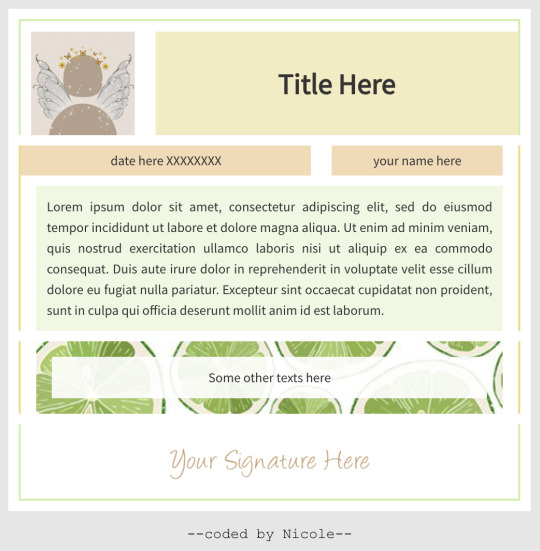
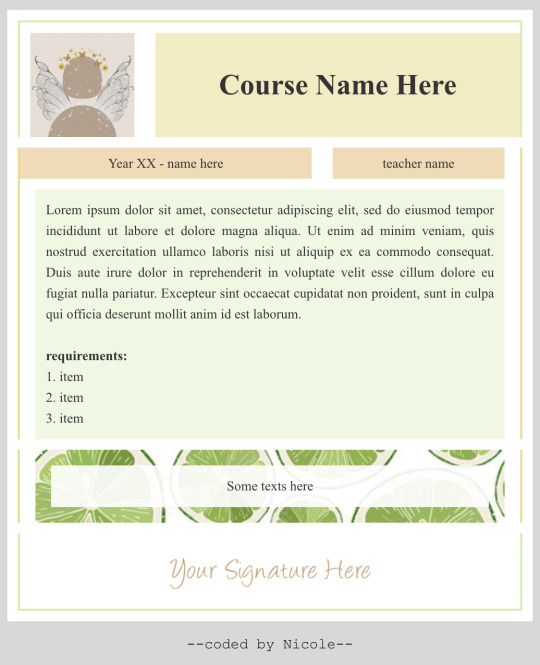
I finally finished my first ever class overview code that did not break right in front of my eyes HAHAHA
It took ridiculously long to get it right, so I hope it'll work for you too
Matching Article & Lesson code: here
Please read the TERMS OF USE before using my code <3
Link: v.1 (wallpost) || v.2 (class overview)
#wox#css#code#html#woxcode#free#wox wallpost#wallpost#course#class overview#nickycodes#coder's choice#overview
27 notes
·
View notes
Text
Midnight Abyss
The matching overview code for the Dark Temptation Lesson Code. It is quite simple with the space for your as well as your AT's face claims, a place to introduce the class, write about the requirements of the course and put down the information about your Owls.
Keep the credits and if you have any queries you can contact me at ala25.
Code: https://pastebin.com/9sWNfh0e
#world of potter#wox#code#woxcode#rpg#worldofolympians#aesthetic#html#overview#wallpost#owl#club overview#welcome mail#mailbox#multiple mails#owls
5 notes
·
View notes
Text
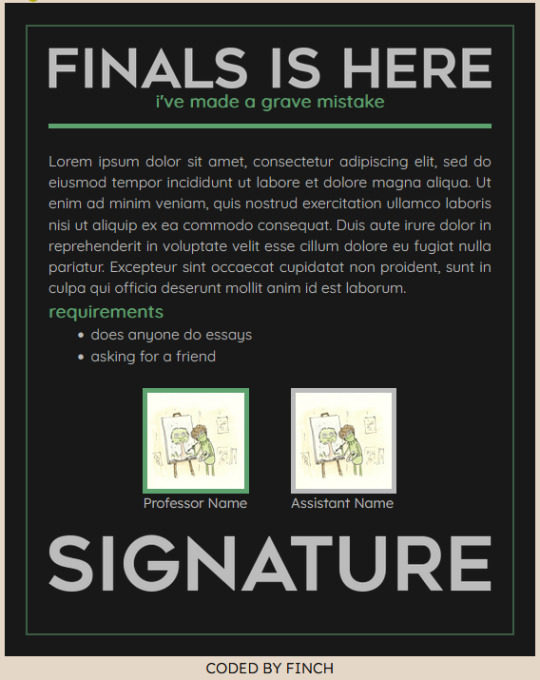
finals is here | course overview a friend of mine requested a silly little course overview with my previous article code, but this can also function as a wallpost too once again only inline css so you'll have to find the colors manually to switch out (5ea26f, rgba(94, 162, 111, 0.5), bbbbbb, good luck) title is font meme there is no god pastebin
#coding#world of olympians#world of potter#html#html template#css#wox site#wox#course overview#wallpost
12 notes
·
View notes
Text
Overview: Dark Arts

Hi hello!
If you were thinking that my name was unfamiliar, you got it right. I am a newcomer in this community. And, honestly, I'm a bit nervous-
Today I made my very first code from scratch. And … here it is! It might not be perfect yet (I was not lying that I am a newbie, hahaha). However, I hope this simple code might be useful for everyone who needs it, especially those who looking for a lesson overview!
I made this code for WoP ID, therefore I used it there too. But don't worry, you can also use it on another site. Just keep the credits at the end of the codes!
This code has:
title and subtitle area
overview area
requirements box
two picture boxes for the professor and the assistant
footer note (optional use)
Some of you may think my code seems similar to older codes by other coders, but I can guarantee that I wrote this code from scratch (thanks to w3schools!). ^^
Lastly, here's the link: pastebin
15 notes
·
View notes
Text
trying to update my hatchling probability tool again from a different device than usual, accessing the online editor is such a giant hassle every time somehow
#tütensuppe#ggle does NOT want you to access this thing#i ended up finding a link in the docs but going there from your project overview? good luck#just brought the sheet up to date earlier today and the py script still works like a charm.#generated a new html file from the sheet in like 2 seconds#SUCH an upgrade from making all the changes by hand damn
2 notes
·
View notes
Text
Overview code 1989
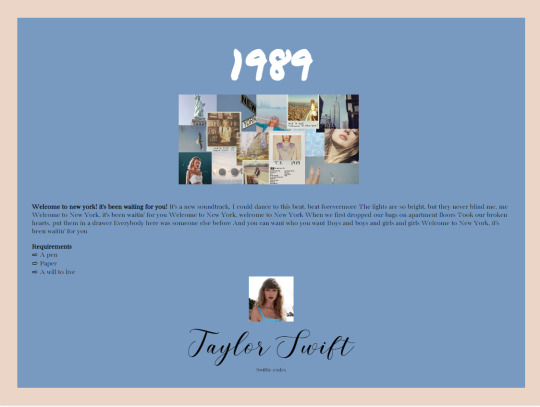
Hello, lovelies!!
I hope ya'll are great! So I am doing this thing where I'm making code inspired by Taylor Swift albums, the last time I did TTPD and this time I'm doing 1989! I hope you like this code!
don't remove credits <3
Link
6 notes
·
View notes
Text
New Year ♦️ Wallpost
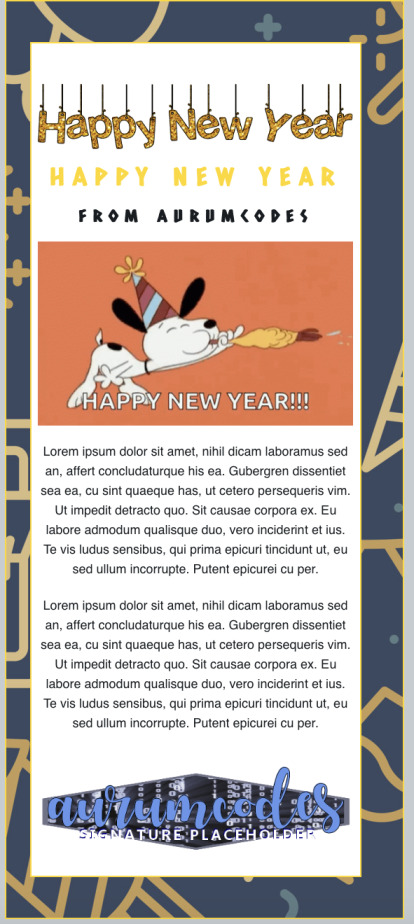
Features: ♦️ Fun New Year's Theme ♦️ Gif and signature space ♦️ Responsive
Code: HERE
Rules: ♦️ Keep my credit ♦️ Do not claim as your own ♦️ Enjoy!
If you have any questions, let me know!
5 notes
·
View notes
Text
Class Overview: Dark Orange
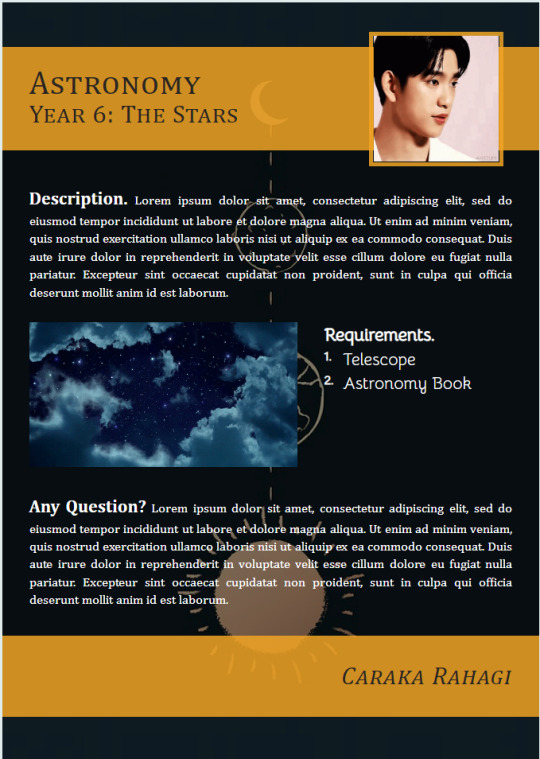
0 notes
Text
Conform is a type-safe form validation library utilizing web fundamentals to progressively enhance HTML Forms with full support for server frameworks like Remix and Next.js.
0 notes
Text
Best code learning websites, learn to code for beginners, learn online coding
Best code learning websites for how long it takes to learn to code, it really depends on your goals, dedication, and the complexity of the language. HTML is relatively simple and you can get a good grasp of its basics in a few weeks if you dedicate a few hours each day. However, mastery and fluency might take a few months of consistent practice.Online Tutorials and Courses: Websites like Codecademy, freeCodeCamp, and W3Schools offer free tutorials on HTML. They provide interactive lessons that guide you through the basics and more advanced concepts. There are many free tutorials on YouTube covering HTML for beginners.
The time it takes to learn coding can vary depending on several factors, including the programming language you choose, the how long to learn coding complexity of the projects you want to work on, and your prior experience with technology. However, many people can acquire basic coding skills in a few months with consistent effort.Learning to code for free is very much possible with the resources available online. Many platforms offer free courses and tutorials. While paid courses might offer more comprehensive content and support, you can definitely start and make significant progress without spending any money.
Coding teaches you how to break down complex problems into smaller, more manageable parts and develop logical solutions. Critical Thinking: Programming encourages logical thinking and improves your ability to analyze and solve problems. Coding allows you to create something from scratch, whether it's a website, app, or game. It's a way to express creativity through technology. In today's technology-driven world, coding is a valuable skill that is in high demand across various industries.
Coding enables you to automate repetitive tasks, making processes more efficient. Career Opportunities: Knowing learn coding for beginnershow to code opens up a wide range of career opportunities in fields such as software development, data science, web development, and more. Start with Basics: Begin with a beginner-friendly language like Python.
This hands-on experience is crucial for learning. Books and Documentation: Read coding books and explore documentation. Understanding how to use documentation is a vital skill for programmers. Participate in online coding communities like Stack Overflow or Reddit. Engaging with others can provide support and insights.
Best Code Learning Websites best coding language to learn firstOffers interactive coding lessons for various programming languages. Provides courses from universities and organizations worldwide. Similar to Coursera, edX offers a wide range of courses from universities and institutions. Focuses on project-based learning and offers nanodegree programs.
A nonprofit organization that provides free coding lessons and projects. Offers introductory coding courses in an interactive and beginner-friendly manner. A great resource for web development, offering tutorials on HTML, CSS, JavaScript, and more.
0 notes
Text
Needle Lace Resources
This is a very long post, so I'm including a cut.
Tutorial-like Things, Others' Work
An overview of the stages of needle lace (specifically learning from Alençon, I believe. They link to a documentary type of video on Alençon lace): https://www.taixtile.com/needle-lace-first-steps/. This blog has links to other resources (one link is broken, if I recall correctly).
A very approachable first project, I think. From a lace maker who has done very cool illustrations with lace, Maggie Hensel-Brown: https://youtu.be/OLuRpJ96p4Q?si=gqBWqYxa755gFozr
This channel has videos of the stages of needle lace making. They specifically demonstrate Irish lace, I believe. But the stages are very similar to or the same as the stages in Alençon lace. https://youtu.be/dZVagIFCnLc?si=d8lRnPsmz5iTM0Z_
Pierre Fouché has a video about making dense filling stitches and even doing short rows to makes curves (something I tried but did not yet succeed at): https://youtu.be/DK5cMQND3b8?si=qySmT9yaoTcpsUV9 He also does really cool bobbin lace illustrations by constructing patterns in cell-like units.
An embroiderer tries needle lace in two videos. In one of them she tries different styles from different places: https://youtu.be/eTO7dA4oyl4?si=VInx35kql115bIIo https://www.youtube.com/watch?v=A9Wa6-Qf5xw
Example of a different style of needle lace. Unsure what it is exactly. Some sort of cut work or reticella, idk: https://youtube.com/shorts/7DFogWC3tDI?si=uju74sPFbRj3_wrn
Sampler directions: https://youtu.be/oDKBfjDYBnU?si=shQYvaT4kAZD7BgV
Again, a more geometric style of needle lace. I don’t know the particulars of this style (styles?), since I’ve mostly been looking into styles similar to Alençon because I’m aiming for more illustration-like lace. This channel has multiple videos demoing and explaining that process: https://youtu.be/gJd6mkrsUCQ?si=AfVIiwljHvfismrX https://www.youtube.com/watch?v=R6dk721UwW4
Not so much instructions but video of a very skilled lacemaker working on a project: https://youtu.be/01H2GdEXLrs?si=2suFHSG4Kwa6Yl2m
Another lacemaker's work on their blog. I don’t know if they do as much lace making as they do other needle arts https://www.robesdecoeur.com/blog/needlelace-my-work-so-far
A lacemaker's work... the site is older and kind of tricky to navigate. Like. there's no home button, as far as I can tell. Album of their work: https://www.lacemakerslace.oddquine.co.uk/album/index.html Home page, I think: https://www.lacemakerslace.oddquine.co.uk/
Useful/Interesting Things to Know
Alençon lace -- specific French style from the Alençon region, which has a history of point lace and a current institution dedicated to preserving the skills and producing lace. This is the style that I was looking at examples of to try and learn from.
Search terms like different styles of lace that I’m not qualified to talk about but you can look into and do research on: Battenburg, point de gaze (very very fine work, like gauze)… More to be added as I learn about them.
The terms "needle lace" and "point lace" are both used to refer to lace made with a needle. I'm unclear on if there are subtle distinctions between them or if it's simply a matter of location. But having versions of a search query for both terms should help find more results than just using one.
Encyclopedia of Needlework by Therese De Dillmont is an excellent resource to learn how to do different stitches. It seems these stitches mostly come from Irish lace, according to the book. HTML copy of book available on Project Gutenberg here: https://www.gutenberg.org/files/20776/20776-h/20776-h.htm I recommend using ctrl+f to search for "lace stitch" on the page. The end of each chapter in the HTML version seems to have a link to the Table of Contents that is at the end of the entire document. It has chapters for plenty of other needle arts, so it's a good resource all around.
If you want to find examples of needle lace, look on Wikimedia Commons! Using a variety of search terms will help you find more material for inspiration/observation than otherwise
If you want to design your own needle lace depicting objects, it might be worth looking at stained glass to see how larger shapes are broken up into smaller shapes that still feel complete.
You can use multiple colors! Let yourself use multiple colors, like stained glass!
Thoughts from the Learning Process So Far (some terminology used here, look them up so you know what the actual definitions are, but I’ll define what I mean by them)
Tacking vs Couching... I'm unsure about the actual definitions so I may be using them wrong here. In the videos I’ve seen tacking seems to be making a stitch that runs along the way the cordonnet will run. Couching seems to be just when the thread that secures the cordonnet comes up through the backing and goes down through the backing at the same point. With these definitions… Tacking went faster for me than doing couching, but it feels a lot less secure and precise for the form of lace I’m making. Unless I made the tacking stitches perpendicular to the cordonnet's path, the outline cord moved too much due to tension. If it's perpendicular and not a very short stitch, it might get in the way of your filling stitches or binding off stitches. Which might be fine, since you pull them out anyways. But it would also mean more holes in the backing, and at some point the holes are too close together and might tear the backing and pattern. I don't like that. Couching—much, MUCH more tedious for me because I’m not practiced at making the needle come up in exactly the right spot. but it feels more secure to me. The outline seems to be less affected by tension as you work. And I took some shortcuts for couching that helped. I don’t couch the doubled cord, instead I whip stitch back over the already-secured cord. I might make a post to demonstrate what I mean. It kind of messes with the shape/placement of my cordonnet, but for the sake of my impatience I’m willing to sacrifice the precise shape.
Backing material... To use fabric in backing like the instructions usually say, or not? Idk. For me, it’s hard to find the right hole for the couching stitches when I can't see my pattern from the back. It took a lot of trial and error until I got a feel for how to predict where my needle would come up. I don't like the way the poke-and-check method of stitching the cordonnet down tends to rip the pattern up (at least, with my easy-to-access materials. Probably better with better materials and more practice. Using my thumb to find approximately the right spot helped, but not enough). So I just used a sandwich of tape/paper/tape as my backing. If you're willing to fuss around with fabric in your backing, it might make it easier to remove the couching threads after you're done, and when I tried. The directions I've seen usually say to use a backing of doubled-up fabric, clay paper (I'm unsure what this is. might be a thicker paper than cardstock, or it might be paper made to contain clay particles. Probably more like the first option), and contact paper. My last attempt at making a backing used notebook paper (or other type of paper) with packaging tape on both sides to provide a smooth surface and structure. I think it worked fairly well, and I didn't have to figure out where to buy contact paper (or figure out exactly what contact paper was).
#lace making#fiber arts#needle lace#instructions#tutorials#information#resources#my post#i will make this cleaner/easier to read later
125 notes
·
View notes
Text
My full review on the Eltingville Club comics

After a long month of work I've decided to treat myself to read ALL of Eltingville Club, overall this was one of the funniest and saddest comics I've seen AND BEFORE I START!! If your new to the fandom or haven't found a place to read it: https://batcave.biz/27970-the-eltingville-club-2016.html have fun!!
Alright, this is a long one so if you love extensive overviews your in luck!
My favorite moments ੈ✩‧₊˚ Jerry being geeked out is really funny to me

THE WAY THEY LOCK IN 😭

Josh being a bisexual for a panel

I actually love jerry in a hoodie he looks so cutie

Good to know that Pete knows how to read

Me listing off my hyperfixiations to make me feel better

Idk why but Pete's reaction is so funny to me 😭

For some reason Joe looks way better in the comics, still a dick head tho

A moment of clarity for the boys

Common Josh L 😭

fuck'n 😮

Top 10 moments before disaster

THE ZONEEE

Josh being an absolute hater

The slow decline of man


Greedo318 gotta be my favorite character

Bill being a classic manipulative little shit

The one time Josh and Bill actually team up 😭

PREACH PETE!

You wont like me when I'm angry ahh Bill 😭

This Fan, This Monster ੈ✩‧₊˚
One of the most saddest chapters and the one that absolutely broke my heart as much as anyone who's read this comic.

Now we know what happened to Iron Jaw

It was kinda sad seeing Bill in shock that Joe isn't really that cool

I feel SO BAD for the geek girl

Its nice to see Pete stand up for the others

THE INFAMOUS FIGHT SCENE!!

PETEEEE MY KINGGG 😭😭😭

The most HEARTWRENCHING PANEL OF MY LIFE

My Overview ੈ✩‧₊˚
They just wanted to enjoy friends who liked the same things they did but power and greed can corrupt anyone and so manipulative minds that were raised from broken families learn that if your not at the top your nothing in this life. I understand that people have hyperfixiations and obsessions but what happens when someone loves something so much they lose what they have in their real life.
Many times mentioned in the comic people who were ex fans tell Bill to repent and stray away from his fandom that has corrupted him and twisted him into a man with no soul for anything else than a lust and hunger for things that aren't even real.
It does show a real harsh lesson of obsession and how far people will go to achieve such heights. The eltingville club was a very funny comic but the end made me think for a minute about how people like to go so far for things they can't achieve, in doing so destroying their own lives. I feel we could learn a lesson from this comic, weather it be about obsession, relationships, and oppressing sexuality to keep a quota. I loved this comic, and now to read the epilogue.
STAY TUNED FOR THE NEXT POST!
ELTINGVILLE CLUB FAN OUT!!! 📕
#pete dinunzio#eltingville bill#eltingville jerry#eltingville pete#the eltingville club#eltingville josh#welcome to eltingville
36 notes
·
View notes
Text
BG3 Photomode Tutorial #2.5: More Scene Manipulation
Chapter 0: Overview
Chapter 1: Script Extender Debug Console
Chapter 2: Scene Manipulation
Chapter 2.5: More Scene Manipulation
Chapter 3: Otis_Inf Camera Tools
Supplement: Mods and Resources
In continuing from the last tutorial, I wanted to talk about how you find and play cutscenes. There's a couple ways to do this but I will show you my way because I think it is the most thorough way if you need to figure out what flags you may need to edit in order to get this working. It'll also give you the tools you need to troubleshoot flag settings.

In the above screenshot, you can see a cutscene that is meant to be played in the Shadowcursed lands: The cutscene where you play the Lyre to summon Kar'niss. It is a complex scene with tags to resolve and multiple NPCs - some of which aren't humanoid.
I will show you how to find a scene based on a snippet of dialog, how to locate its name and UUID so you can plug it into this command:
Osi.QRY_StartDialogCustom_Fixed("SCL_Drider_Caravan_HalfOrcCaster_865adfae-1b72-1ed2-f961-d55abd4fb7b1","S_GOB_DrowCommander_25721313-0c15-4935-8176-9f134385451b",Osi.DB_Avatars:Get(nil)[1][1],"S_Player_Gale_ad9af97d-75da-406a-ae13-7071c563f604","S_Player_Astarion_c7c13742-bacd-460a-8f65-f864fe41f255", 1,1,-1,1)
Warning: Please keep in mind, this is still a very finicky process. Again, take it slowly. And please don't be afraid to ask for help if you're struggling. Once you get the hang of it, you can pull out scenes and troubleshoot them into playing with ease.
There's also a good chance I'm glossing over something and not explaining it clearly/accurately. Please send me an ask, DM, comment to clarify anything that's confusing!
BG3 Dialog Reader
In order to do this my way, you'll need to download BG3 Dialog Reader and generate HTML files that include all the dialog of the game. There's already a very lovely tutorial on how to do this, so I recommend you follow it. EDIT: Or download their parsed files from their Google Drive: BG3 - parsed dialogue (1.7).zip
You've probably seen posts in this format before:

So you should now have HTML files located somewhere on your system. You need to search for a line that you'll find in the cutscene you want. Now you need to ask yourself: What line can I search for that is unique to that cutscene so that if I search for it I will get exactly what I'm looking for?
In the Drider-Lyre scene I recall an NPC asking "Did you bring the lyre?" so that's what I searched for. I use the Everything search tool because it's awesome and search for the file like so:

You will need to take a look at this file later, but for now, just take note of the name: SCL_Drider_Caravan_HalfOrcCaster. This is the first half of what you need to complete the first parameter in the command at the beginning. And we are going to use this to find the UUID.
Finding the UUID
To find the UUID, you're going to need another tool. The BG3 Modder's Multitool. Go to their GitHub, look along the right column and click on the link in the Releases section.

After that, click on bg3-modders-multitool.zip to download it. Extract the files to a new folder somewhere handy and run bg3-modders-multitool.exe.
In BG3 Modder's Multitool, click on Configuration and set the bg3.exe location to your Baldur's Gate 3 executable (E:\Program Files (x86)\Steam\steamapps\common\Baldurs Gate 3\bin or something along those lines). The Documents folder should auto-populate but you may want to double check it.

Now click in Search Index. It's going to start a process where it searches through the BG3 files. This can take a while the first time, but will be instant after that.

Once it's complete, you can now take the name of the scene and pop it into the new Index Search window that popped up.

In the results on the left, there will be a lot of files that list it, but I generally look for ones that say Assets\Dialogs\[PAK] and end in _merged.lsf and click on it. Then click Convert & Open.
This should open in Notepad or Notepad++. Now search this file for "SCL_Drider_Caravan_HalfOrcCaster" - keep in mind there can be MULTIPLE results. Note that the first instance you will get is SCL_Drider_Caravan_HalfOrcCaster_AtTower. This is the wrong scene.
You are now looking in the code a couple lines above that string for a value that is an ID type and has a value that's a lot of letters and numbers. This is the UUID.

So you have what you need to create this first parameter. Combine SCL_Drider_Caravan_HalfOrcCaster with the string of letters and numbers separated by an underscore. Like so:
SCL_Drider_Caravan_HalfOrcCaster_865adfae-1b72-1ed2-f961-d55abd4fb7b1
Plugging into the StartDialogCustom Command
Note that this copies straight in to this command in the first parameter:
Osi.QRY_StartDialogCustom_Fixed("SCL_Drider_Caravan_HalfOrcCaster_865adfae-1b72-1ed2-f961-d55abd4fb7b1", "S_GOB_DrowCommander_25721313-0c15-4935-8176-9f134385451b", Osi.DB_Avatars:Get(nil)[1][1], "S_Player_Gale_ad9af97d-75da-406a-ae13-7071c563f604", "S_Player_Astarion_c7c13742-bacd-460a-8f65-f864fe41f255" ,1,1,-1,1)
Now on first glance this looks pretty much like other times I've shown you this command, except note that there's FOUR actors. When a cutscene doesn't play at first (after double checking the UUID), this is very often the reason why. This is the minimum because the roles for the half-orc and Karniss need to be filled. First position is Kansif the Half-Orc, second is Tav, third is Brawler Vez, and fourth is Kar'niss.
Note: Kar'niss CAN be played by a non-Drider NPC - they will float angrily around carrying the lantern. It's hilarious. Try it. Here's when I tried it with my Tav:

Setting and Clearing Flags
Now. Depending on where and when you play this scene, the scene may or may not play or it will quit early. There could be a few reasons for that. The UUID could be wrong, the number of actors could be wrong, or a flag could be set that's not supposed to be set.
Let's have a look at the BG3 Dialog Reader file for this scene to see what flags are in use.

By default you should be able to see checkflags (blue) and setflags (orange). Look at the top of the page for a reminder of what the colors mean. The blue check flags are checking to see if the flag is set or not. If SCL_Drider_HasMet_CaravanFirstTime = False then you have met the drider caravan yet and this line will play. You will notice that after that is the orange SCL_Drider_HasMet_CaravanFirstTime setflag. That means the game will NOW set the flag as you have now met the Caravan for the first time. There may be occasions where you need to change the flags to get a cutscene to play. Here's the good news: There's handy commands for that!
print(GetFlag("flag",Osi.DB_Avatars:Get(nil)[1][1]))
Osi.ClearFlag("flag", Osi.DB_Avatars:Get(nil)[1][1])
Osi.SetFlag("flag",Osi.DB_Avatars:Get(nil)[1][1])
The bad news is you will have to find the UUID for each flag! So we gotta go back into BG3 Modders Multitool and search for the flag SCL_Drider_HasMet_CaravanFirstTime
Thankfully, you'll only get one result and the big string of letters and numbers is the UUID you need.

Now you combine them like you did with the cutscene name and UUID before, separated by an underscore: SCL_Drider_HasMet_CaravanFirstTime_39e94029-84f7-418d-ddce-8947bcbb7688
So let's say the cutscene isn't playing because you're on a save where that scene has already played. Clear the flag on your Tav: Osi.ClearFlag("SCL_Drider_HasMet_CaravanFirstTime_39e94029-84f7-418d-ddce-8947bcbb76", Osi.DB_Avatars:Get(nil)[1][1])
And I think we will leave it at that. I realize this was a LOT to cover. Go through this very slowly. It will take time to understand what is happening here.
And as always, if you have something you're trying to do and you're struggling with the directions, I can try to help! Please send me a DM, Ask, whatever else and I'll gladly help you with whatever you're trying to do.
Thanks for reading and sticking through this so far!
#okay just... if you don't know coding#take a deep breath and tackle this one section at a time - this is a lot#bg3 photomode#bg3 photography#mog's bg3 virtual photography tutorial#bg3#bg3 virtual photography#baldur's gate iii#baldur's gate 3
53 notes
·
View notes
Text
Overview: Basic Potions
Just uploaded the 3rd code because... why not. :D
After finished the Lesson code, I decided to code the Overview as well so it can be a complete set!
This code has:
big image on top
module's name and year
module's title
description area
requirements box
two picture boxes for the professor and the assistant
footer note (optional use)
As always, please keep the credits at the end of the codes!
Link: Lesson Overview
1 note
·
View note